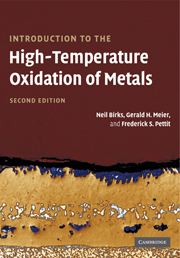Book contents
- Frontmatter
- Contents
- Acknowledgements
- Preface
- Introduction
- 1 Methods of investigation
- 2 Thermodynamic fundamentals
- 3 Mechanisms of oxidation
- 4 Oxidation of pure metals
- 5 Oxidation of alloys
- 6 Oxidation in oxidants other than oxygen
- 7 Reactions of metals in mixed environments
- 8 Hot corrosion
- 9 Erosion–corrosion of metals in oxidizing atmospheres
- 10 Protective coatings
- 11 Atmosphere control for the protection of metals during production processes
- Appendix A Solution to Fick's second law for a semi-infinite solid
- Appendix B Rigorous derivation of the kinetics of internal oxidation
- Appendix C Effects of impurities on oxide defect structures
- Index
Preface
Published online by Cambridge University Press: 05 June 2012
- Frontmatter
- Contents
- Acknowledgements
- Preface
- Introduction
- 1 Methods of investigation
- 2 Thermodynamic fundamentals
- 3 Mechanisms of oxidation
- 4 Oxidation of pure metals
- 5 Oxidation of alloys
- 6 Oxidation in oxidants other than oxygen
- 7 Reactions of metals in mixed environments
- 8 Hot corrosion
- 9 Erosion–corrosion of metals in oxidizing atmospheres
- 10 Protective coatings
- 11 Atmosphere control for the protection of metals during production processes
- Appendix A Solution to Fick's second law for a semi-infinite solid
- Appendix B Rigorous derivation of the kinetics of internal oxidation
- Appendix C Effects of impurities on oxide defect structures
- Index
Summary
Few metals, particularly those in common technological applications, are stable when exposed to the atmosphere at both high and low temperatures. Consequently, most metals in service today are subject to deterioration either by corrosion at room temperature or by oxidation at high temperature. The degree of corrosion varies widely. Some metals, such as iron, will rust and oxidize very rapidly whereas other metals, such as nickel and chromium, are attacked relatively slowly. It will be seen that the nature of the surface layers produced on the metal plays a major role in the behaviour of these materials in aggressive atmospheres.
The subject of high-temperature oxidation of metals is capable of extensive investigation and theoretical treatment. It is normally found to be a very satisfying subject to study. The theoretical treatment covers a wide range of metallurgical, chemical, and physical principles and can be approached by people of a wide range of disciplines who, therefore, complement each other's efforts.
Initially, the subject was studied with the broad aim of preventing the deterioration of metals in service, i.e., as a result of exposing the metal to high temperatures and oxidizing atmospheres. In recent years, a wealth of mechanistic data has become available. These data cover a broad range of phenomena, e.g., mass transport through oxide scales, evaporation of oxide or metallic species, the role of mechanical stress in oxidation, growth of scales in complex environments containing more than one oxidant, and the important relationships between alloy composition and microstructure and oxidation.
- Type
- Chapter
- Information
- Publisher: Cambridge University PressPrint publication year: 2006



